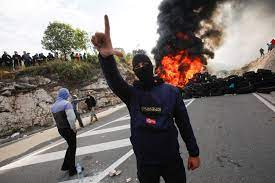Developments in the small Balkan state of Montenegro are a signifier of creeping fascism across the wider region, orchestrated by the pro-Putin Vučić regime in Belgrade but largely ignored by European governments.
The General Election on August 30th 2020 was seen by the international community as a victory for democracy when the ruling coalition of Social Democrats and Democratic Socialists lost power after nearly 30 years. A 70% turnout in the middle of a pandemic resulted in a relationship between a new right-wing, populist, pro-Serb coalition government and the sitting Democratic Socialist President without tensions or violence. This was the narrative promoted by the EU and wider international community.
One year on and nothing could be further from the truth, with the new government undermining civil society and the multicultural and multi-confessional essence of Montenegro on a daily basis. The influence of clerical fascism from the hard-line Serb Orthodox Church (SOC) permeates every level of government, including the appointment of Zdravko Krivokapić as Prime Minister. Seasoned observers living in the Balkans warned of dangers in late 2019 when the SOC openly took a political position by attacking the then progressive government. The implementation of the ‘Freedom of Religion’ law in early 2020 was weaponised by the SOC, who viewed it as a declaration of hatred and oppression. In fact the new ‘law’ was viewed as a positive development by the Venice Commission. It brought the SOC in line with other religions in Montenegro, decreeing that all religious institutions would be seen as equal, must register ownership of property and land, and would be subjected to relevant taxes and obligations to the state.
For a century the SOC had avoided paying taxes and refused to prove or register ownership of churches it stole in 1919 when it subjugated the Montenegro Churches and took over their ownership. This was a year after the Kingdom of Montenegro was subsumed into the Kingdom of Serbia/Slovenes and Croats at the end of WW1. In the months prior to the 2020 election the SOC organised huge demonstrations for its followers, effectively advising its flock to vote ‘For the Future of Montenegro’, a coalition of pro-Serb parties who intended to roll back the progress on independence which has been in process since a referendum in 2006 saw Montenegro break with Serbia.
Coalition partners with ‘The Future of Montenegro’ include the Democratic Front, whose main party is the PzP led by Nebojša Medojević. In 2019, PzP founded Steve Bannon’s ‘Movement’ with Lega and the Brothers of Italy. A smaller coalition partner is led by URA (United Reform Action), whose leader, Dritan Abazović, is a strong supporter of the Serb Orthodox Church. The main positions in the new government are Prime Minister Krivokapić, a devout follower of the SOC and, as deputy PM, Abazović, who claims that his party are green and grassroots despite being financed by the Vijesti newspaper, which is partially owned by the right-wing Austrian media company Styria. A third important government position is held by Aleksa Bečić, President of Parliament. Bečić’s party is called the Democrats, but he is known to be both pro-Serb and pro-SOC despite rebranding himself in recent years. All of these political appointments were ordered by the late Amfilohije Radović (head of the SOC) before he succumbed to Covid-19. At Radović’s funeral all Covid safety measures were ignored and thousands of mourners, led by Krivokapić, Medojević and Bečić, did not observe social distancing or mask wearing.
It should be noted that all current ministers are devout followers of the SOC. Vesna Bratić, the minister for education, culture, sport and science, is from Srpska Republic (in Bosnia Herzegovina) and only took Montenegrin citizenship a few years ago. She declared herself to be a Chetnik (who were infamously WW2 Nazi collaborators) and praised the SOC’s role during the Yugoslav wars of the 1990s. She has fired most directors of education institutes, universities and schools and replaced them with people loyal to the SOC. Bratić is also changing the school curriculum and encouraging the teachings of the SOC doctrines.
Human rights and civil society activists have been threatened or detained for questioning by the police, and right-wing news portals such as In4S (a radical Serb outfit) make death threats to anyone asking questions of the government. Vile anti-Montenegrin graffiti has become so commonplace that the media no longer reports it. Many NGOs say nothing about what the government is doing, although criticism of the last administration was frequent and public. President Vučić of Serbia has often spoken publicly about a ‘Serb World’ – a triangle of Banja Luka (Srbska Republic), Podgorica (Montenegro) and Belgrade (Serbia ) – where Serbs will be ‘protected’. This is reminiscent of Milošević’s chilling ideal of the 1990s.
The international community is either guilty of turning a blind eye to recent developments or is ignorant of the facts. Montenegro was far from perfect under the last regime, but it did stay true to its multi-ethnic, secular anti-fascist principals. The most important national day is July 13th when, in 1878, the Berlin Congress recognised Montenegro as a sovereign state. It also marks the beginning of the People’s Partisan Uprising against the Nazi occupiers in 1941. At this year’s 80th anniversary of that uprising, President Milo Đukanović addressed a huge crowd of thousands of people including foreign dignitaries – and not a single government official took part. History may be in the process of being rewritten along with a repeat of the ethnic violence that led to unspeakable crimes against humanity.

